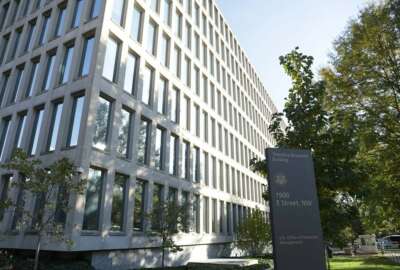

The House Oversight and Accountability Committee pressed Office of Personnel Management Director Kiran Ahuja on federal telework, hiring process reforms, the...
Office of Personnel Management Director Kiran Ahuja faced a bombardment of tough questions from Congress about the agency’s operations and the future of the federal workforce.
House Republicans on the Oversight and Accountability Committee pressed Ahuja for answers on improper payments in the Federal Employees Health Benefits (FEHB) Program, efforts on federal hiring reform, two management-level OPM employees’ cases of sexual harassment, a retirement case backlog and much more during a March 9 hearing.
Among the broad array of topics on OPM’s operations, members continued circling back to one that has become quite familiar: telework.
Federal telework is far from a new conversation on Capitol Hill, gaining attention over the last three years after the number of government employees working from home skyrocketed as a result of the COVID-19 pandemic.
Republicans have strongly pushed against federal telework. The House passed the SHOW UP Act at the beginning of the 118th Congress along party lines. It’s legislation that would return federal employees to pre-pandemic work spaces, and largely reduce federal telework opportunities.
“Returning to in-person work means returning to the core mission of each federal agency, which is to serve the needs of the American people,” Committee Chairman James Comer (R-Ky.) said during the committee hearing. “Unfortunately, case work backlogs and slow response times have become routine complaints since the pandemic … That’s why we’re holding this hearing today — accountability.”
With a Democrat majority in the Senate, Republicans’ SHOW UP Act is not likely to become law. In place of passing legislation, the path for the House majority to advance many of their priorities has lately come through more aggressive investigations of the Biden administration and its programs and agencies.
This week, the Oversight and Accountability Committee held seven hearings in the span of just two days. Members are probing fraudulent payments of pandemic relief programs, advances in artificial intelligence (AI) and inflation, to name just a handful.
Many of the committee’s investigations of government programs inherently tie back to the federal employees who are doing the work. And committee Republicans repeatedly said that telework worsens the delivery of federal services at agencies like the Social Security Administration, the IRS and the Department of Veterans Affairs.
“The federal government is not at work,” Rep. Pete Sessions (R-Texas) said during the hearing.
“Federal employees are not showing up to work. That is a fact,” Rep. Nancy Mace (R-S.C.) said.
“Still near 50% aren’t back at work,” Rep. Glenn Grothman (R-Wis.) said.
Ahuja, though, argued that the idea of not showing up to work mischaracterizes the federal workforce. She and many other advocates of telework have continually tried to clarify the distinction between “return to work” and “return to the office.” OPM emphasizes the importance of telework and remote work options as helpful tools for federal workforce recruitment and retention.
“[Agencies] have also seen the positive impact workplace flexibilities have on areas such as productivity, engagement and diversifying the talent pool,” Ahuja said during the hearing. “To that end, OPM is focusing on how we can better assist agencies to meet their workforce needs.”
Rep. Gerry Connolly (D-Va.), an advocate of federal telework, said there is also a distinction between telework during the pandemic, and the longer term telework policy for agencies.
“Robust telework programs existed before the pandemic and will exist after the pandemic. And we want them. We want them well managed, we want them overseen, we want them productive, we want them improving morale,” Connolly said. “And we want to use those programs as part of the toolkit when we’re recruiting the next generation of federal employees who expect it, because they get it in the private sector.”
Connolly added that three years into the pandemic, changes to workplace arrangements should be further reflected in OPM’s telework policy, now that President Joe Biden has made plans to lift the national and public health emergencies this May.
“I think that then calls for new guidelines for personnel,” Connolly said.
OPM, however, does not have any plans underway to change the current telework guidelines for agencies, according to Ahuja.
“We are simply emphasizing what we’ve been emphasizing since the beginning — utilize these workplace flexibilities so they can serve agencies,” Ahuja said. “We have seen in a number of cases where telework has actually improved productivity, improved performance. Employee engagement scores are actually tied to — and have much higher scores — for teleworkers. This is about analyzing every agency in its unique space, and the work that they do to determine how best they can deliver on mission.”
One area of agreement between the parties was a desire for more data to determine whether or not telework actually works for agencies. The difference, though, is that Republicans are looking to first return feds to the office, then consider additional data and make decisions from there.
“We would support telework if we have evidence that it saves money and doesn’t cost efficiency and productivity in the federal government,” Comer said. “If telework is the way to go, and it saves money, and doesn’t do anything to harm the productivity of the federal employees, we will go along with it.”
On the other hand, Democrats lean more toward collecting data on the benefits of telework, while keeping many feds on their current telework schedules in the meantime.
The question of the federal government’s physical footprint has also aligned House Republicans in part with D.C. Mayor Muriel Bowser, who has called on the White House to either return feds to the office, or give up its leases to make space for other businesses and homes that will use it.
Exact numbers of federal employees who are teleworking, versus working remotely, versus working in person, can be difficult to parse. The most current information OPM has publicly available comes from the Federal Employee Viewpoint Survey (FEVS), which asked respondents about their work locations.
According to the 2022 FEVS, which received an overall response rate of 35%, one quarter of federal employees currently telework three or more days per week. And one-fifth of feds said they are required to be physically present and do not telework.

OPM’s most recent report to Congress on the status of federal telework, published in December 2022, was based on data from fiscal 2021. At the time, agencies reported that 47% of employees participated in routine or situational telework during 2021, a 2% increase from the previous year.
Still, Republicans on the committee voiced frustrations about the lack of clear information on the actual numbers of federal teleworkers and remote workers.
“You can’t or won’t answer questions on how many federal employees work from home,” Mace said during the hearing. “You can’t even tell us the most basic data about how many federal employees worked from home before COVID, during COVID and now after COVID.”
But a clearer picture of telework numbers for the federal workforce may be on the horizon. OPM issued a memo that will soon require agencies to collect and report more data on remote work and telework for each individual federal employee.
That data, OPM said, will “have the potential to improve governmentwide reporting of federal employee participation in remote work, telework and mobile work, as well as allow OPM to evaluate trends and determine how such work arrangements might advance the accomplishment of mission-critical requirements and organizational effectiveness.”
OPM has urged agencies in its latest guidance to maximize workplace flexibilities and continue using telework and remote work options.
Copyright © 2025 Federal News Network. All rights reserved. This website is not intended for users located within the European Economic Area.
Drew Friedman is a workforce, pay and benefits reporter for Federal News Network.
Follow @dfriedmanWFED


